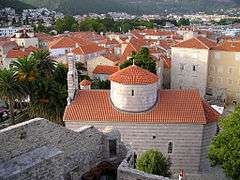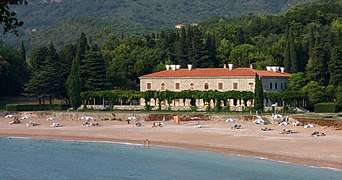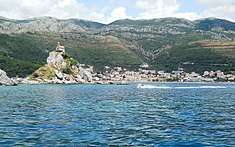Budva
Budva (Cyrillic: Будва, pronounced [bûːdv̞a] or [bûdv̞a]) is a Montenegrin town on the Adriatic Sea, former bishopric and present Latin Catholic titular see. It has 19,218 inhabitants, and it is the centre of Budva Municipality. The coastal area around Budva, called the Budva riviera, is the center of Montenegrin tourism, known for its well-preserved medieval walled city, sandy beaches and diverse nightlife. Budva is 2,500 years old, which makes it one of the oldest settlements on the Adriatic coast.[2]
Budva Будва | |
|---|---|
Town and municipality | |
   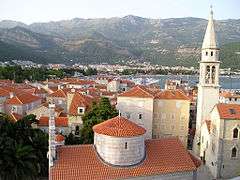 Budva panoramic view, Dancer statue in front of Old Town, Sveti Stefan island, Bečići and Budva Old Town | |
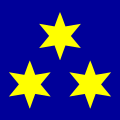 Flag  Coat of arms | |
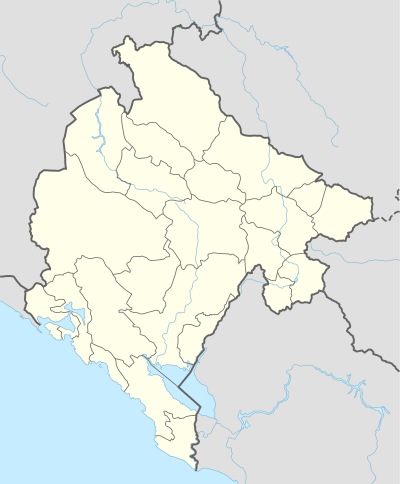 Budva Location of Budva | |
| Coordinates: 42°17′17″N 18°50′33″E | |
| Country | |
| Municipality | Budva Municipality |
| Settlements | 33 |
| Government | |
| • Mayor | Nikola Divanović |
| • Ruling coalition | DPS–CG–SD |
| Area | |
| • Town and municipality | 4.2 km2 (1.6 sq mi) |
| • Metro | 122 km2 (47 sq mi) |
| Elevation | 3 m (10 ft) |
| Population (2011 census)[1] | |
| • Urban | 13,338 |
| • Rural | 5,880 |
| • Municipality | 19,218 |
| Time zone | UTC+1 (CET) |
| • Summer (DST) | UTC+2 (CEST) |
| Postal code | 85310 |
| Area code | +382 33 |
| ISO 3166-2 code | ME-05 |
| Car plates | BD |
| Climate | Csa |
| Website | budva.me |
Etymology
According to Ernst Eichler and others, Budva is ultimately derived from the Albanian word butë.[3] In Montenegrin the town is known as Будва or Budva; in Italian and Latin as Budua; in Albanian as Budua and in ancient Greek as Bouthoe (Βουθόη).[4]
History
Extensive archaeological evidence places Budva among the oldest urban settlements of the Adriatic coast. Substantial documentary evidence provides historical references dating back to the 5th century BC.
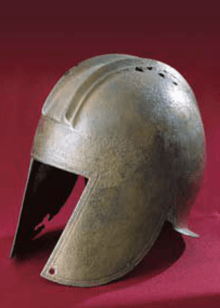
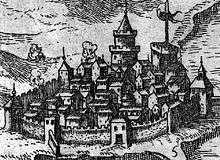
A legend recounts that Bouthoe (Βουθόη - Vouthoe) was founded by Cadmus, the founder of Thebes, Greece, when exiled out of Thebes, finding a shelter in this place for him and his wife, goddess Harmonia.
Greek colonization of Adriatic began in the 4th century BC, when an Emporium was established on the site of Budva. In the 2nd century BC, the area of Budva became part of the Roman Empire. Upon the fall of the Empire and its division into east and west, the defensive barrier which separated the two powers happened to run across this area, subsequently making a lasting impact on the history and culture of this town.
In the 6th century, Budva was part of the Byzantine Empire, and in the following two centuries, Slavs and, to a lesser extent, Avars began to arrive in the area, mixing with the native Roman population. Budva bay was reportedly known as Avarorum sinus (Avar bay') during the Avar incursions. In 841, Budva was sacked by Muslim Saracens, who devastated the area.
In the early Middle Ages, Budva was reigned by a succession of Doclean kings, as well as Serbian and Zetan aristocrats.
.jpg)
Circa 1200, it became the see of a Roman Catholic Diocese of Budua, which lasted until 1828 and was nominally revived as a Latin titular bishopric. The Venetians ruled the town for nearly 400 years, from 1420 to 1797. Budva, called Budua in those centuries, was part of the Venetian Republic region of Albania Veneta and was fortified by powerful Venetian walls against Ottoman conquests. According to the historian Luigi Paulucci in his book "Le Bocche di Cattaro nel 1810" (The Bay of Kotor in 1810), most of the population spoke the Venetian language until the beginning of the 19th century. One of the most renowned theater librettists and composers, Cristoforo Ivanovich, was born in Venetian Budua.
With the fall of Republic of Venice in 1797, Budva came under the rule of the Habsburg Monarchy. During the Napoleonic Wars, Montenegrin forces allied with Russia took control over the city in 1806, only to relinquish the city to France in 1807. French rule lasted until 1813, when Budva (along with Boka Kotorska) was ceded to the Austrian Empire, which remained in control of the city for the next 100 years.
A union of Boka Kotorska (and Budva) with Montenegro took place for a brief period (1813–1814), but from 1814 until the end of World War I in 1918, Budva remained under Austria-Hungary. The southernmost fortress in the Austro-Hungarian empire, Fort Kosmač, was constructed nearby to guard the road from Budva to Cetinje. After the war, the Serbian army entered Budva after it was abandoned by Austrian forces and it came under the Kingdom of Yugoslavia.
In 1941, with the beginning of World War II, Budva was annexed by the Kingdom of Italy. Budva was finally liberated from Axis rule on 22 November 1944 and incorporated in the Socialist Republic of Montenegro (which was a part of the Socialist Federal Republic of Yugoslavia).
A catastrophic earthquake struck Budva on 15 April 1979. Much of old town was devastated, but today there is little evidence of the catastrophe – almost all the buildings were restored to their original form.
Montenegro became an independent country in 2006, with Budva as its primary tourist destination.
Local government
The municipal parliament consists of 33 deputies elected directly for a four-year term.
| Party/Coalition | Seats | Local government | |
|---|---|---|---|
| Democratic Party of Socialists | 12 / 33 |
Government | |
| Democratic Montenegro | 7 / 33 |
Opposition | |
| Democratic Front | 7 / 33 |
Opposition | |
| The Montenegrin | 3 / 33 |
Government | |
| Socialist People's Party-Demos | 2 / 33 |
Opposition | |
| SDP-URA-Liberals | 1 / 33 |
Opposition | |
| Social Democrats | 1 / 33 |
Government | |
Mayor
Mayor of Budva is the head of the town and Municipality of Budva. He acts on behalf of the Town, and performs an executive function in the Municipality Budva. Current mayor is Nikola Divanović, member of DPS.
List of Mayors since Montenegrin independence (2006-present):
- Rajko Kuljača (DPS) (2006-2010, arrested)
- Lazar Rađenović (DPS) (2010-2015, arrested)
- Srđa Popović (DPS) (2014-2016, acting)
- Dragan Krapović (Democrats) (2016-2018)
- Marko Carević (DF) (2018–2020)
- Nikola Divanović (DPS) (2020–present)
Demographics
Budva is the administrative centre of Budva municipality, which includes the neighbouring towns of Bečići and Petrovac, and has a population of 19,218 (2011 census).[1] The town itself has 13,338 inhabitants.
Ethnicity in 2011 (Municipality):[1]
Cityscape
Old Town
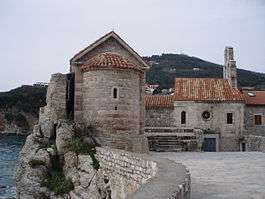
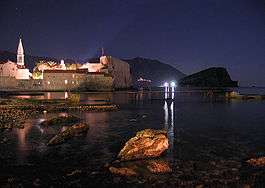
The Old Town of Budva is situated on a rocky peninsula, on the southern end of Budva field. Archaeological evidence suggests that Illyrian settlement was formed on the site of the Old Town before Greek colonization of the Adriatic. While the site was permanently settled since Roman era, most of existing city walls and buildings were erected during the Venetian rule.
The entire town is encircled with defensive stone walls. The fortifications of Budva are typical of the Medieval walled cities of the Adriatic, complete with towers, embrasures, fortified city gates and a citadel.
Originally, there were gates on all of the four sides of the walled city. However, sea-facing gates were closed up over the years. The main city gate is Porta di Terra Ferma, the grand entry to the city from the west. It is also the beginning of the city's main thoroughfare, Njegoševa Street. There are also four more gates on the north wall, facing Budva marina (Porta Pizana, Porta Pizana 1 and 2, and Porta Pizanella), and one small gate facing the southwestern beach of Ričardova glava.
The layout of the town is roughly orthogonal, although many streets deviate from the grid, resulting in somewhat irregular pattern, with many piazzas connected with narrow streets. Today, the entire city within the walls is pedestrian-only.
The town citadel is situated on the southern tip of the city. Originally known as Castle of St Mary, fortification was continually rebuilt and expanded through Middle Ages, reaching its final form during the Austro-Hungarian rule. The sea-facing 160m long ramparts of the citadel, complete with eastern and western towers, are intricately connected to the rest of the city walls. Austrian stone barracks form the most prominent structure within the castle, separating the citadel from the rest of the walled city. Ruins of the Santa Maria de Castello church, after which the entire complex was originally named, are located within the citadel.
A large public square is located to the north of the citadel, containing all of the churches of the old town - St. Ivan Church (17th century), Santa Maria in Punta Church (840 AD),St Sava Orthodox Church (12th century) and The Holy Trinity Orthodox church (1804).
The Old Town suffered extensive damage in 1979 earthquake; repair and reconstruction took eight years (until 1987), but traces of the damage are now hardly noticeable. Today, it is a prime visitor attraction of Budva, packed with tourists during the summer months. Its narrow cobbled streets are lined with restaurants, cafes, pubs and shops.
Outside the Old Town

Although confined to the walls of the Old Town for most of its history, Budva started significant expansion into the adjacent Budva field in the 20th century, with the development of tourism industry. Hotels started springing up near the Old Town and to the west of it, along the 1600m long Slovenska beach, including the landmark Avala hotel (built in 1939), the Mogren hotel, and the Slovenska plaža hotel complex (built in 1984). Development near the Old Town and along the longest city beach was done in a planned and sustainable manner, with parts of Budva built in the SFRY having all the characteristics of a well-organized resort town. Most of the hotels and facilities built during this period are situated to the south of the town's main traffic artery, a portion of Adriatic Highway (E65/E80) that crosses the city parallel to the Slovenska plaža beach.
However, the rest of the Budva field, to the north of the Adriatic Highway, developed in a less uniform manner. The western part of Budva field, containing a civic center (an area featuring local government offices, schools, sports center, police and fire station, health center and bus station), Rozino, Dubovica and Golubovina neighbourhoods, was developed relatively in accordance with principles of urban planning.
In contrast, the eastern part of the Budva field, and slopes of the hills surrounding it, saw the emergence of the chaotic urban sprawl. Spontaneous growth begun in the late 1980s and early 1990s, as a combination of high demand and inability of the state to enforce urban planning, as the Breakup of Yugoslavia took place. This trend continued into the 2000s, with prices of real estate skyrocketing following the Montenegrin independence. Overwhelming demand, fueled by the influx of foreign capital (in large part from Russia), meant that all the undeveloped lots in the Budva field and surrounding hills were quickly being turned into construction sites. Local and state authorities have failed to keep up with the developers, resulting in the unfortunate lack of urban planning in much of the area. Thus, large parts of Budva are connected with an irregular grid of narrow streets, and have overall inadequate infrastructure. This trend continues even today, with limited land forcing developers to turn to building towering high rises in place of small detached residences that made up for majority of Budva field in the early 1990s.
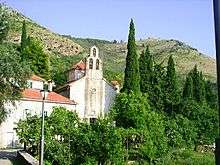
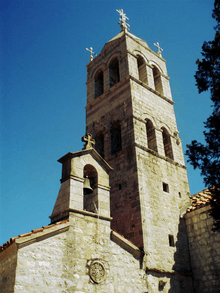
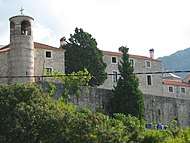
The pressures of the real estate market and neglect of urban planning have resulted in chronic and severe lack of parking space, and frequent traffic jams during the summer. Even the water and electricity supply have failed to keep up with the explosive growth in the 2000s, but those issues have since been addressed.
A testament to the urban sprawl, the city bypass (Obilaznica, a crescent road that circles the northern ends of Budva field, with ends connecting to the Adriatic Highway) is a bypass only in name, as it now a busy urban street, swallowed by the city's expanding urban area.
The term Budvanizacija ("Budvanization") has been used regionally to denote a form of chaotic and massive urban growth, tailored to the needs of individual land owners and developers, without regard for sustainability or environment.
Tourism
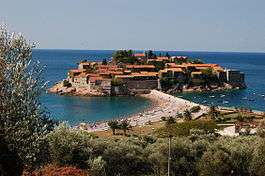
Tourism is the main driver of the economy of Budva. It is a significant tourist destination on the eastern Adriatic, and by far the most popular destination in Montenegro. During the 2013, Budva recorded 668,931 tourist visits, and 4,468,913 overnight stays, thus accounting for 44,8% of tourist visits to Montenegro, and 47,5% of its overnight stays.[5]
Although Budva is notable for its long history and its well-preserved Old Town, it is not primarily known as a destination for sightseeing or cultural tourism. Unlike Kotor or Dubrovnik, Budva has an image of a crowded beach resort, with a lively and vibrant atmosphere and a very active nightlife.
Beaches
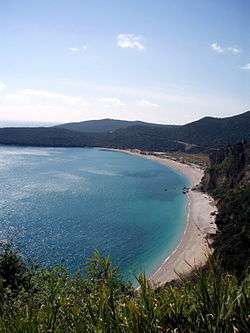
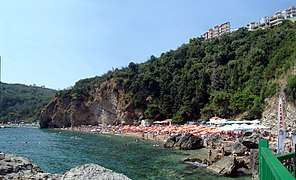
The Budva Riviera has some of the most attractive beaches of south Adriatic, and the most pleasant climate in Montenegro. Mogren beach is arguably the best known and most attractive of the Budva city beaches, nested beneath the cliffs of the Spas hill, between cape Mogren and the Avala hotel. The beach is separated from the city by the slopes of Spas hill that plunge to the sea, and is only accessible by a 250m long narrow path along the cliffs. Other city beaches include the small Ričardova glava ("Richard's Head") and Pizana beaches, next to the Old Town, as well as the 1.6 km (1.0 mi) long Slovenska plaža (Slav beach), that makes up the most of the city's coast.
However, majority of the beaches of Budva Riviera are outside the city itself. Jaz Beach is a long and spacious beach west of Budva, its hinterland serving as a popular concert and festival venue, as well as a campground. Bečići resort town, with its long sandy beach, is situated south-east of the city, separated from Budva by the Zavala peninsula.
Further to the south, numerous small beaches and towns, make up the more high end and exclusive part of Budva Riviera. This is especially true for the famous Sveti Stefan town, but also for other smaller Paštrovići settlements in the area, that once were unassuming fishing villages. The area of Sveti Stefan and Pržno, including Miločer resort with its park and secluded beaches, is considered the most exclusive area of the Montenegrin coast.
The town of Petrovac and the undeveloped Buljarica field occupy the very south of the Budva municipality.
Sveti Nikola Island is located opposite of Old Town, 1 kilometre (0.6 miles) across the Budva bay. It is a mostly undeveloped island with some beautiful beaches. Well connected to the mainland with water bus, it is a popular excursion site for tourists visiting Budva.
Nightlife
.jpg)
Budva is well known regionally as the capital of nightlife of the eastern Adriatic. The first discothèques in Budva started to emerge during the 1980s, as hotel-attached dance clubs. However, the clubbing scene mushroomed in the 1990s, with numerous open-air clubs opening along the Budva sea promenade. This trend continued into the 2000s, with Old Town and its promenade hosting a large number of bars, pubs and restaurants, and two big clubs, Top Hill and Trocadero, dominating the clubbing scene.
Other
Budva is home to the Adriatic Fair (Jadranski sajam), the only specialized exhibition venue in Montenegro. It hosts numerous trade fairs throughout the year, including the only auto show in Montenegro, held annually in autumn.
Gambling tourism is also popular in Budva, as many hotels have attached casinos. Maestral hotel and casino in Pržno are particularly popular among international gamblers, but other large hotels have also attracted players from European countries. The 2006 James Bond film Casino Royale is partly set in the eponymous casino in the fictional Montenegrin Hotel Splendide, thus giving a boost to Budva's profile as a gambling destination.
Budva marina, nestled to the north of the Old Town city walls, contributes to the image of Budva as a nautical tourism destination. Luxury yachts dominate marina berths during the summer, overshadowing small fishing vessels owned by the locals. Budva marina was host to periodic boat shows, but in recent years it has been losing primacy to the larger and more luxurious Porto Montenegro. Budva was the host of the Class 1 World Powerboat Championship Grand prix in May 2008.
Culture
Among the cultural events and establishments in the city, the annual cultural event Theatre City (Budva Grad Teatar) is of particular importance. Founded in 1987, and held in July and August every year, this festival transforms the entire Old Town into an open-air venue for a programme of theatre, musical, literary and visual art events and performances.
Another popular event in Budva was the Pjesma Mediterana ("Song of the Mediterranean"), annual pop musical festival, held in Budva from 1992 to 2010. Its format was similar to that of Sanremo Music Festival, featuring a competition of previously unreleased songs. The song contest attracted popular performers from the EX Yugoslavia region. However, the festival was cancelled in 2011 due to lack of funds, and has not been renewed since.
In 2014, the Sea Dance Festival was organized at Budva's Jaz Beach for the first time.[6] A spin-off of the popular Exit festival, Sea Dance is set to be an annual event. Jaz Beach rose to prominence as a popular concert and festival venue with The Rolling Stones concert held on 9 July 2007. The show was part of their A Bigger Bang Tour and attracted a crowd of some 35,000 spectators, twice the population of Budva town itself. Madonna staged a show attended by 47,000 spectators at the same venue on 25 September 2008, while Lenny Kravitz and Armand Van Helden performed at Jaz beach during the "Live Fest" in August 2008, along with Goran Bregović, Dino Merlin and Zdravko Čolić.
Budva Carnival is a three day long festive event in Budva, happening annually during late April or early May. It has been organized every year since 2003, and although a recent carnival, it has attracted significant regional attention. Budva, together with nearby Kotor, was host to the Federation of European Carnival Cities (FECC) World Carnival City Congress in May 2009.
Budva city museum is one of the prominent cultural institutions in the city, featuring permanent archaeological and ethnographic exhibits. Stefan Mitrov Ljubiša memorial home is another significant institution, honoring the legacy of the famous native of Budva.
Budva occupies a significant place in the history of the cinema of Montenegro, as it was home to the Zeta Film, the Montenegrin primary motion picture company from the Yugoslav era. The now-defunct company has produced numerous Yugoslav movies, including pictures by the famous Montenegrin director Živko Nikolić. Zeta Film was privatized in 2004, and its building was converted to a nightclub, leaving Budva without a single movie theater for a decade. On 30 May 2015, a brand new four screen multiplex cinema opened in TQ Plaza shopping mall.
The city has occasionally provided the backdrop for international movie productions. The 1964 movie The Long Ships was shot in and around Budva, and the prop from the movie, a large 4m tall cracked bell, has been permanently displayed in front of the Old Town walls, becoming one of the local landmarks. Recently, Budva has been the setting and the filming location of the locally produced, and regionally very popular TV series Budva na pjenu od mora (Budva, on the sea foam).
Education
Budva has two elementary schools and one high school. In 2009, city administration founded Knowledge Academy (Akademija Znanja), an institution envisioned to act as a university center and introduce higher education to Budva. The Knowledge Academy building, situated in the Rozino neighbourhood of Budva, is currently home to Budva city library and private Business and Tourism faculty, and serves as the center of higher education of the municipality.
Sports
FK Mogren is the most popular football club in Budva, and the sports club with longest tradition in the city. Founded in 1920, it competes in Montenegrin First League, winning the championship in 2008-09 and 2010-11. The club also won the Montenegrin Cup of 2008. Stadion Lugovi, the home ground of FK Mogren, will probably be relocated in the near future, as it is situated on a very valuable land lot, right next to the Slovenska beach.
OFK Petrovac, from the eponymous town, is another significant football team from the Budva municipality.
Another popular sport in Budva is volleyball, with Budvanska Rivijera volleyball team being successful in domestic and international competition. Mediteranski sportski centar ("Mediterranean sports center") is the main indoor sport venue of Budva, and is the home of Budvanska Riviera volleyball team and RK Budvanska Rivijera handball team.
Water polo is a very popular sport in Budva, as on the rest of the Montenegrin coast. VK Budva is the city's water polo team, competing in the regional Adriatic Water Polo League.
Paragliding is a popular summer activity in Budva. Steep 700m high hills provide perfect setting and stunning vistas for paragliders, with the hamlet of Brajići being the usual launching point.[7]
Transport
Budva is connected to inland Montenegro by two-laned highways. There are two ways to reach Budva from Podgorica – either through Cetinje, or through the Sozina tunnel (opened 2005). Either way, Podgorica, the capital and main road junction in Montenegro, is around 60 km (37 mi) away.
Budva is connected to the rest of the coastal towns of Montenegro by the Adriatic Highway, which extends from Ulcinj in the far south to Herceg Novi in the north, and on to Croatia.
Tivat Airport is 20 km (12 mi) away. There are regular flights to Belgrade and Moscow throughout the year, and dozens of seasonal and charter flights land daily at the airport during the summer season. Podgorica Airport is 65 km (40 mi) away, and it has regular flights to a number of European destinations throughout the year.
Urban transport consists of Mediteran Express buses, which operate between Budva city center and Sveti Stefan. This line services a large portion of the Budva urban core, as well as some small towns between Budva and Sveti Stefan. The frequency of this line is high during the summer months, and it is very popular among tourists.
The closest train station is Sutomore. This stop on Belgrade–Bar railway is some 30 km (19 mi) away from Budva city center.
Twin towns – sister cities










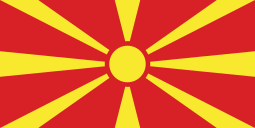











References
- "Montenegrin 2011 census". Monstat. 2011.
- Istorija i legende, Budva.com
- Eichler, Ernst; Hilty, Gerold; Löffler, Heinrich; Steger, Hugo; Zgusta, Ladislav (2008). Namenforschung / Name Studies / Les noms propres. 1. Halbband. Walter de Gruyter. p. 718. ISBN 3110203421.
- Kako je nastalo ime Budva?, Kolektiv
- "Tourism statistics 2013" (PDF). Monstat. 2014.
- "EXIT festival will be held in Novi Sad and Budva". B82. 6 December 2013. Retrieved 7 December 2013.
- Sport u Budvi, Budva.me
- "Gradovi pobratimi". budva.me (in Montenegrin). Budva. Retrieved 28 December 2019.
- "Градови побратими". gradbijeljina.org (in Serbian). Bijeljina. Retrieved 28 December 2019.
Sources and external links
| Wikimedia Commons has media related to Budva. |
| Wikivoyage has a travel guide for Budva. |
.jpg)
